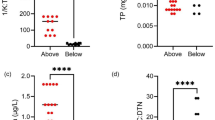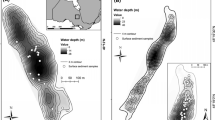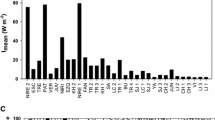Abstract
Bacterial abundance and production in a vertical profile in Lake Kariba (17dgS), Zimbabwe, were affected by solar irradiance. At the surface, 1.87 × 109 bacteria 1−1 were found and abundance peaked at 10 m (2.5 × 109 bacteria l-1), then decreasing with depth. Bacterial reproduction at the surface(0.145 µg C1−1 h−1) was nearly four times less than the production at 10 m although bacterial numbers were only 26% less. Thus, bacterial production per cell was lower at the surface than deeper down, suggesting that bacterial production is inhibited at the surface.
Bacterial production in GF/F filtered lake water in Whirl Pack™ bags showed an exponential decrease down to 3 m depth. The inhibition was well in accordance with light extinction in the UV region. Phosphatase activity was low in light exposed bags compared to dark, indicating photolysis of extracellular enzymes, or phototransformation of recalcitrant DOM, which substitutes enzyme activity. Hypolimnetic enzyme activity was less affected by solar light than epilimnetic.
Similar content being viewed by others
References
Chróst, R. J., 1989. Characterisation and significance of ß- glucosidase activity in lake water. Limnol. Oceanogr. 34: 660–672.
Chróst, R. J., 1991. Environmental Control of the Synthesis and Activity of Aquatic Microbial Ectoenzymes. In R. J. Chróst (ed.), Microbial Enzymes in Aquatic Environments. Springer Verlag New York Inc.
Chróst, R. J. & B. Velimirov, 1991. Measurements of enzyme kinetics in water samples: effect of freezing and soluble stabiliser. Mar. Ecol. Prog. Ser. 70: 93–100.
Gleason, J. F., P. K. Bhartia, J. R. Herman, R. McPeters, P. Newman, R. S. Stolarski, L. Flynn, G. Labow, D. Larko, C. Setor, C. Wallenmeyer, W. D. Komhyr, A. J. Miller & W. Planet, 1993. Record low global ozone in 1992. Science 260: 523–526.
Helbling, E. W., V. Villafane, M. Ferrario & O. Holm-Hansen, 1992. Impact of natural ultraviolet radiation on rates photosynthesis and on specific marine phytoplankton species. Mar. Ecol. Prog. Ser. 80: 89–100.
Herndl, G. J., G. Müller-Nicklas & J. Frick, 1993. Major role of ultraviolet-B in controlling bacterioplankton plankton growth in the surface layer of the ocean. Nature 361: 717–719.
Hoppe, H. G., 1983. Significance of exoenzymatic activities in the ecology of brackish water: measurements by means of methylumbelliferyl-substrates. Mar. Ecol. Prog. Ser. 11: 299–308.
Karentz,D., M. L. Bothwell, R. B. Coffin, A. Hanson, G. J. Herndl, S. S. Kilham, M. P. Lesser, O. Lindell, R. E. Moeller, D. P Morris, P. J. Neale, R. W. Sanders, C. S. Weiler & R. G. Wetzel, 1994. Impact of UV-B radiation on pelagic freshwater ecosystems: Report of working group on bacteria and phytoplankton. Arch. Hydrobiol. Beih. 43: 31–69.
Lindell, M. J., W. Granéli & L. J. Tranvik, 1995. Enhanced bacterial growth in response to photochemical transformation of dissolved organic matter. Limnol. Oceanogr. 40: 195–199.
Mayer, L. M., 1989. Extrecellular protolytic enzyme activity in sediments of an internal mudflat. Limnol. Oceanogr. 34: 973–981.
Porter, K. G. & Y. S. Feig, 1980. The use of DAPI for identifying and counting aquatic microflora. Limnol. Oceanogr. 25: 943–948.
Sieracki, M. E., & J. M. Sieburth, 1986. Sunlight-induced growth delay of planktonic marine bacteria in filtered sea water. Mar. Ecol. Prog. Ser. 33: 19–27.
Smith, J. & F. Azam, 1992. A simple, economical method for measuring bacterial protein synthesis rates in seawater using 3H-leucine. Mar. Microb. Food Webs. 6: 107–114.
Smith, R. C., B. B Prézelin, K. S. Baker, R. R. Bidigare, N. P. Boucher, T. Coley, D. Karentz, S. MacIntyre, H. A. Matlick, D. Menzies, M. Ondrusek, Z. Wan & K. J. Waters, 1992. Ozone depletion: Ultraviolet radiation and phytoplankton biology in Antartic waters. Science 255: 952–959.
Worrest, R. C., 1982. Review of literature concearning the impact of UV-B radiation upon marine organisms. In Calkins J. (ed.), The role of solar ultraviolet radiation in marine ecosystems. Plenum Press, New York: 429–457.
Author information
Authors and Affiliations
Rights and permissions
About this article
Cite this article
Lindell, M., Edling, H. Influence of light on bacterioplankton in a tropical lake. Hydrobiologia 323, 67–73 (1996). https://doi.org/10.1007/BF00020548
Received:
Revised:
Accepted:
Issue Date:
DOI: https://doi.org/10.1007/BF00020548




